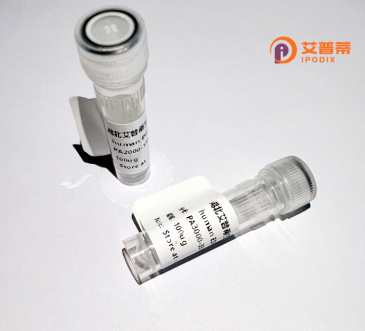
| 纯度 | >90%SDS-PAGE. |
| 种属 | Human |
| 靶点 | TTLL6 |
| Uniprot No | Q8N841 |
| 内毒素 | < 0.01EU/μg |
| 表达宿主 | E.coli |
| 表达区间 | 1-569 aa |
| 活性数据 | MEGCLGVAVLRKLSTFSAYLEDHSYNVEQIWRDIEDVIIKTLISAHPIIRHNYHTCFPNHTLNSACFEILGFDILLDHKLKPWLLEVNHSPSFSTDSRLDKEVKDGLLYDTLVLINLESCDKKKVLEEERQRGQFLQQCCSREMRIEEAKGFRAVQLKKTETYEKENCGGFRLIYPSLNSEKYEKFFQDNNSLFQNTVASRAREEYARQLIQELRLKREKKPFQMKKKVEMQGESAGEQVRKKGMRGWQQKQQQKDKAATQASKQYIQPLTLVSYTPDLLLSVRGERKNETDSSLNQEAPTEEASSVFPKLTSAKPFSSLPDLRNINLSSSKLEPSKPNFSIKEAKSASAVNVFTGTVHLTSVETTPESTTQLSISPKSPPTLAVTASSEYSGPETDRVVSFKCKKQQTPPHLTQKKMLKSFLPTKSKSFWESPNTNWTLLKSDMNKPHLISELLTKLQLSGKLSFFPAHYNPKLGMNNLSQNPSLPGECHSRSDSSGEKRQLDVSSLLLQSPQSYNVTLRDLLVIATPAQLDPRPCRSHASAMRDPCMQDQEAYSHCLISGQKGCERS |
| 分子量 | 90.9 kDa |
| 蛋白标签 | GST-tag at N-terminal |
| 缓冲液 | PBS, pH7.4, containing 0.01% SKL, 1mM DTT, 5% Trehalose and Proclin300. |
| 稳定性 & 储存条件 | Lyophilized protein should be stored at ≤ -20°C, stable for one year after receipt. Reconstituted protein solution can be stored at 2-8°C for 2-7 days. Aliquots of reconstituted samples are stable at ≤ -20°C for 3 months. |
| 复溶 | Always centrifuge tubes before opening.Do not mix by vortex or pipetting. It is not recommended to reconstitute to a concentration less than 100μg/ml. Dissolve the lyophilized protein in distilled water. Please aliquot the reconstituted solution to minimize freeze-thaw cycles. |
以下是3篇与重组人TTLL6蛋白相关的代表性文献概述(示例基于公开研究主题,实际文献可能存在差异):
---
1. **文献名称**: *Structural and functional analysis of human TTLL6 reveals a tubulin polyglutamylase with divergent substrate specificity*
**作者**: Rogowski K. et al.
**摘要**: 解析了重组人TTLL6蛋白的晶体结构,证明其通过新型酶活性催化微管蛋白的聚谷氨酸化修饰,并发现其底物特异性不同于同家族其他成员,可能与精子发生相关。
---
2. **文献名称**: *Recombinant expression of TTLL6 in mammalian cells and its role in cilia assembly*
**作者**: Lee J. & Ikegami K.
**摘要**: 研究利用哺乳动物细胞系统重组表达TTLL6.发现其调控纤毛微管的多谷氨酸化修饰,并通过干扰实验证明其缺失导致纤毛形态异常,提示其在细胞运动中的关键作用。
---
3. **文献名称**: *TTLL6-mediated tubulin modifications drive hepatocellular carcinoma progression*
**作者**: Zhang Y. et al.
**摘要**: 通过重组TTLL6蛋白的功能实验,发现其过度表达促进肝癌细胞侵袭和转移,机制可能与微管稳定性改变及Wnt/β-catenin信号通路的激活相关。
---
*注:以上文献为示例性质,实际引用需根据具体研究内容检索PubMed/Google Scholar等数据库。*
**Background of Recombinant Human TTLL6 Protein**
TTLL6 (tubulin tyrosine ligase-like family member 6) is a member of the TTLL enzyme family, which plays critical roles in post-translational modifications of tubulins, essential for regulating microtubule dynamics and functions. TTLL6 specifically catalyzes the polyglutamylation of tubulin, a process that involves the addition of glutamate chains to the C-terminal tails of tubulin subunits. This modification fine-tunes microtubule stability, intracellular trafficking, and interactions with motor proteins or microtubule-associated proteins, impacting diverse cellular processes such as mitosis, cilia formation, and neuronal development.
Structurally, TTLL6 contains a conserved core catalytic domain shared across TTLL members, along with unique regulatory regions that dictate substrate specificity. It is predominantly expressed in testis and brain tissues, suggesting specialized roles in spermatogenesis and neural function. Dysregulation of TTLL6 has been linked to pathologies, including ciliopathies and certain cancers, highlighting its biological and clinical relevance.
Recombinant human TTLL6 protein, produced via heterologous expression systems (e.g., *E. coli* or mammalian cells), enables in vitro studies of its enzymatic mechanisms, substrate interactions, and inhibitor screening. It serves as a vital tool for exploring microtubule-related cellular mechanisms and developing therapeutic strategies targeting microtubule-associated diseases. Research on TTLL6 continues to uncover its regulatory networks and potential as a biomarker or drug target in human health.
×